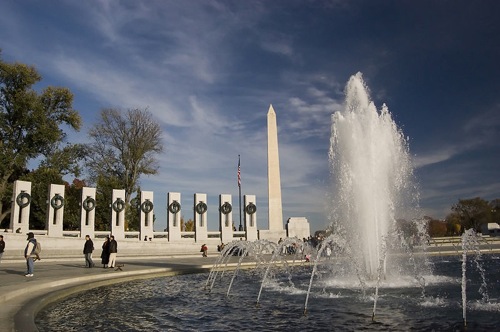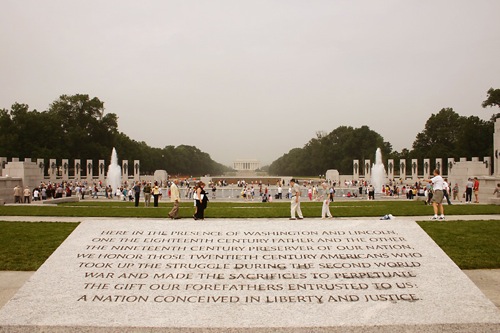My class and I went to Washington D.C. We saw monuments, memorials, and museums. One memorial that really hit me was the World War II Memorial. It interested me not only because of the war itself, but because it was made in honor of every person who served in this war. It is also in honor of those who suffered and had their lives affected at home. People who had family serving put a blue star in their window showing that they had a son or daughter in service. Often this was replaced by a gold star, meaning that person was another casualty of the war.
This memorial is gargantuan. It is really touching to see a beautiful memorial for the veterans to see. This memorial is located between the Lincoln Memorial and the Washington Memorial. A ring of pillars surrounds an exquisite fountain. These pillars represent the 56 territories, U.S. states, and the District of Columbia. Two twin pavilions, marked Pacific and Atlantic, face each end. They represent the war fought across two oceans. At the base of the pavilions are key battles of the war. The wall facing the Lincoln Memorial is called the Freedom Wall. It holds 4,000 stars, each representing 100 soldiers who gave their lives for this war. Each star is handmade and not all the same flat star. The architect wanted every little thing to be special. On each side of this wall there is a small fountain with cascading water. On each side of the ceremonial entrances are bas-relief sculptures that depict scenes of America at war.



President Harry S. Truman once said, "Our debt to the heroic men and valiant women in the service of our country can never be repaid. They have earned our undying gratitude. America will never forget their sacrifices." This one quote is inscribed in the memorial. It really sums up what the memorial is all about.
Wreaths of oak and wheat rotate on each of the sides. These wreaths symbolize our nation's industrial and agricultural strength. Both of these were essential to the global success of the war. Under the Freedom Wall is written, "Here we mark the price of freedom." I feel that this reflects what the architect wanted for this wall.
The location is also symbolic. It is between the Washington and Lincoln memorial, which represents the ideals of democracy that were preserved through this war. These ideals were won by George Washington and defended through Abraham Lincoln. This war was " . . . fought across six of the world's seven continents and all of its ocean's," British historian, John Keegan wrote.
My trip to this memorial was one I'll never forget. I saw veterans while I was there; I could only imagine what they went through. I wanted to say something such as thank you, but my shyness got the better of me. The one thing that struck me the hardest was the Freedom Wall. The best way to experience this is to see it. Words can only cover so much. You could tell that the architect wanted this to be as special as possible. The impact of this memorial could only be expressed so much.
The whole visit to Washington D.C. was great. Every monument and museum was worth walking around for hours on end. I wouldn't trade this experience for anything. I would recommend visiting the World War II Memorial as well as any other thing you can visit. I would also recommend the Holocaust Museum. If I was allowed more time to stay in Washington D.C. I would take it in a heartbeat. This was a once in a lifetime event to be with my classmates.
Author's Note: All information came from a brochure handed out at the memorial. This brochure was written by the National Park Service, U.S. Department of the Interior.